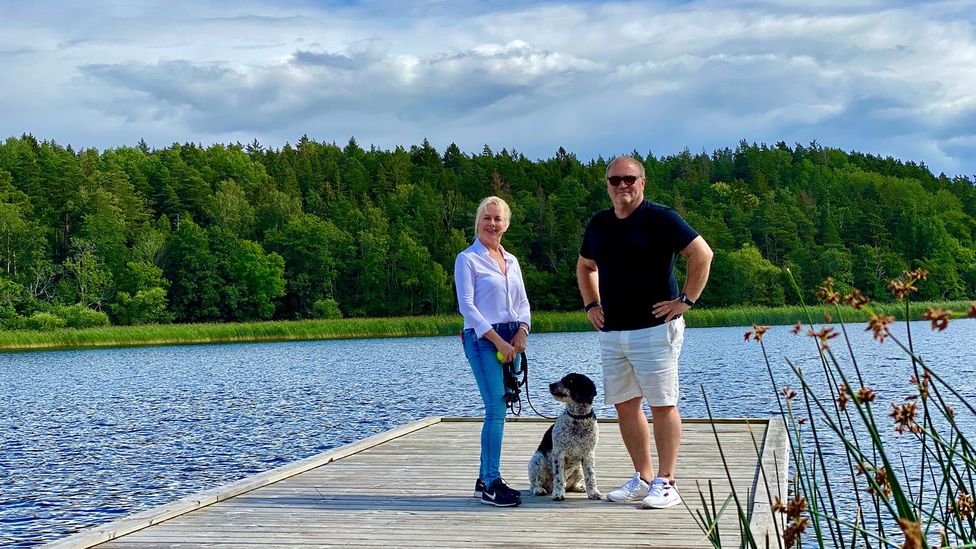Swedes have long embraced their version of staycations: hemester. Now, Covid-19 travel restrictions and remote working are reshaping the tradition.
The sweet, refreshing aroma of the surrounding pine forest wafts onto the beach at Årsunda, a lakeside tourist spot in Gävleborg, central Sweden. As in many parts of the world, staycations are popular here this summer, with Covid-19 putting would-be travellers off venturing too far from home. Plus, Swedish tourists are more limited in where they’re allowed to go internationally than many other Europeans, with some countries imposing travel restrictions due to the Nordic nation’s high infection rate in relation to its population size.
“We were supposed to go to Sicily earlier in the year, but that didn’t happen, so we came here instead,” says Saga Norman, a student who’s tucking into a salad at a beachside restaurant. “But it’s actually pretty common we are up here in the summer.”
The 22-year-old lives in Stockholm, but her parents own a traditional Swedish wooden summer house – built by her grandfather – near the lake. “There’s fewer people, it’s much quieter and it gives a soothing feeling that you can’t get in cities,” adds her digital-marketer boyfriend Alexander Sandvik, 23, who has joined her for the trip.
Even before Covid-19, there was a long-running national obsession with staycations in Sweden. Here, they’re known as ‘hemester’, which comes from the Swedish words for home, ‘hem’, and holiday, ‘semester’. While hemester can mean you’re simply staying put in your apartment or house during your annual leave, it is also commonly used to talk more generally about taking a vacation anywhere within your own country. Despite a growing trend for international holidays over the past few decades (before the Covid-19 pandemic, Swedes were among the most-travelled nationalities in the world), spending time in summer homes remained a calendar staple for both wealthy families and those on lower incomes.
“I think in the Swedish mentality, it becomes something almost necessary in order to connect with nature and recharge your batteries for long, dark and cold winter,” explains Jennifer Dahlberg, a US-born blogger and author who is currently writing a book set in the Stockholm archipelago, where she’s spent summers for the past two decades.
Alexander Sandvik and Saga Norman, both in their 20s, had to change their 2020 holiday plans due to Covid-19, so they opted to stay in the country (Credit: Sandvik and Norman)
Recapturing traditions
For a large proportion of Swedes, hemester is an experience similar to Norman and Sandvik’s idyllic lakeside break. Around 20% of the population own a summer cottage or cabin (classified as such because they can’t be used during colder winter months), while more than 50% have access to one via family or friends, according to Statistics Sweden. Meanwhile there’s no lack of beauty spots; two-thirds of the country is covered in forest, there are 30 national parks and nearly 270,000 islands.
The Stockholm archipelago is a popular staycation spot, though real estate can get pricy (Credit: Jennifer Dahlberg)
Swedes have plenty of time for hemester-ing too, with most employers offering staff a minimum of 25 days annual leave. Many companies and organisations also allow employees to take four consecutive weeks off, typically between late June and mid-August. (Cue a deluge of out-of-office responses while attempting to research this article in the middle of the hemester season.)
Gunnar Andersson, a professor of demography at Stockholm University who replied from his aunt’s summer cottage in Östergötland in southern Sweden, says the hemester tradition is partly linked to the country’s historically rural lifestyle.
“Only a few generations ago, most people lived out in the forest, in the countryside. And before we were urbanised, we lived on farms that were much, much more scattered than other parts of Europe.” This means that many people still have family roots in rural locations, he says, while others want to keep up the Nordic tradition of spending time close to nature, known as friluftsliv, even if they usually live and work in cities. “You also see that when people have children, then suddenly it’s very important that [they] should have access to being close to a forest.”
Dahlberg observes that while owning a second home is viewed as “rather elite” in many countries, Swedes tend not to consider it such a privilege, with properties often passed down through generations. “A lot of these summer residences are things that perhaps were acquired at reasonable prices,” she explains. “Not every home is equipped to the nines. Many of them are very rustic – you may not have indoor plumbing.”
Dahlberg reflects that whatever the size or the price of a staycation property, many Swedes have a similar approach when it comes to hemester activities. While flopping on a lakeside beach might play a role, walks, sport and DIY are also common pastimes, especially among those bunching together four weeks or more off work.
“They’re very active. Some people paint their houses. There’s boating life, kayaking, windsurfing,” she says. “I think the most exhausting thing can be socialising, because Swedes become very social during this period. There are lots of lunches, dinners or picnics – although social distancing is of course important now.”
US-born author Jennifer Dahlberg thinks that rural staycations in Sweden close to nature help people recharge before a long, dark winter (Credit: Dahlberg)
In Östergötland, professor Andersson lists mushroom foraging and berry picking as other common staycation pastimes, and says he’s often kept busy doing small-scale renovations and gardening. “There’s a little lake here and we are also going fishing. Last week we were out getting crayfish, which was a kind of enjoyment.”
Social distancing and remote working
On Hemnet, the country’s largest listings site for properties, summer homes currently for sale in Gävleborg in central Sweden start from one-room renovation projects available for 200,000 kronor ($23,000) to high-spec four-bedroom houses with large gardens fetching 3,000,000 kronor ($344,000). Prices are cheaper in more remote locations further north, but significantly higher in the archipelago surrounding the capital, Stockholm, where a small cabin could set you back more than 1,000,000 kronor ($115,000) and mansions on private islands sell for 30,000,000 kronor ($3,438,000).
Despite Sweden’s economy experiencing its biggest hit for at least 40 years during the peak of the Covid-19 pandemic, estate agents have reported rising demand for summer houses in 2020. Prices in June were 9% higher than a year ago, according to national Swedish broker statistics, while villas suitable for year-round living also nudged up by 2%. Separate figures from Hemnet show that between 15% to 25% more vacation homes have been sold each week over the last few months compared to the same period last year.
Despite Sweden’s economy experiencing its biggest hit for at least 40 years during the peak of the Covid-19 pandemic, estate agents have reported rising demand for summer houses in 2020
Amir Kabbani, an agent at Länsförsäkringar Fastighetsförmedling, a major realtor in Sweden, says it is important to put the summer house boom in the context of several years of low interest rates and a growing national environmental movement led by Swedish teenager Greta Thunberg. However, he believes Covid-19 is by far the largest driving factor, with growing numbers of Swedes seeking staycation properties in beauty spots, because travelling abroad remains challenging.
“You can come out here, to the nature, and it’s very calming and relaxing,” he explains from his office in Gustavsberg, a waterfront town in the Stockholm archipelago. “In the city it’s pretty crowded and if you live in an apartment, if you have children inside playing, it’s a tough environment.”
According to national statistics, around 20% of Swedes own a summer cottage, while 50% have access to one via friends or family (Credit: Stalin Sathitharan Veerakumar)
With the Public Health Agency advising Swedes to continue working from home, he says the majority of buyers in his region are also looking for properties where they can work efficiently. This means that places with fibre broadband, strong phone signals and suitable home-office space are attracting more attention than rustic retreats. Meanwhile Kabbani says the average age of potential buyers has dropped, with more couples in their 30s showing up for viewings. “It’s become kind of trendy to have a summer house… it’s people having good jobs, having a good cash flow and now [finding it] easier to work outside Stockholm and stay away from the city.”
At Hemnet, spokesperson Staffan Tell says the listings site has also identified an increasing nationwide interest in homes which optimise the remote working experience. “Detached houses and vacation homes have been in great demand, whereas apartments have been less popular relatively speaking,” he says. “More people are dreaming about having their own garden. Being able to have a home office and more living space also appears to be more popular than before.”
Priced out of the market
There are some concerns that the rising interest in summer homes may fuel an already growing income gap in Sweden, a country with a reputation for championing equality. Families who own properties are set to benefit from the high demand, since they can sell at inflated prices or make money from renting them out to holidaymakers. But those without second homes could end up even further from entering the market.
“I think there is a risk of getting a difference in how we spend our vacations,” says Lena Lid Falkman, an economist and expert in work-life trends at Stockholm School of Economics. “Since there is such a need and interest for summer homes, prices go up so the people that are less rich don’t have the same possibilities.”
Not every home is equipped to the nines. Many of them are very rustic – you may not have indoor plumbing – Jennifer Dahlberg
There are no national figures on the ethnicity of summer home owners in Sweden, but residents born abroad or with two non-European parents are set to be disproportionately affected. These groups are already less likely to spend time in these kinds of properties compared to native Swedes, according to research for Statistics Sweden.
“I’ve been a single mum for about five years and with two kids and a mortgage for our main home, I’m not able to stretch my finances,” says Noor Sisask, 39, an Iraqi-born citizen who works for an e-learning start-up in Stockholm. She and her children are obsessed with nature and would jump at the chance to have their own cabin, but instead typically go camping or stay with friends over the summer. “I still feel we’re privileged to be able to afford to do some fun things despite not having our own place,” she reflects. “I think many Swedes have been used to [second home ownership] and don’t perhaps see what a luxury it is. That’s easier for immigrants to spot and desire.”
Julian Stubbs, a branding professional from Stockholm, thinks that technology and Sweden’s flexible work culture will spur more remote working in rural areas (Credit: Stubbs)
Reviving rural communities
Despite rising prices and demand for second homes, some experts believe there will be a silver lining when it comes to Covid-19 and the summer property ladder, especially for middle-income, dual-earning couples. This is because the remote-working boom is making it easier to invest in less expensive areas further away from buyers’ base cities.
“We have seen a tendency that more people are searching for homes outside of their county of residence. It is hard to know for certain if this is because of Covid-19, but it is possible that as more people are working from home, proximity to the office becomes less important,” says Staffan Tell at Hemnet.
Julian Stubbs, who runs a global branding agency from Stockholm and is an author and speaker on remote working, believes that will eventually lead to growing numbers of Swedes living in the countryside more permanently.
“I think there’s going to be a trend of people moving out of cities, actually moving to cheaper locations where they can afford a better life,” he says. Although this tendency is also emerging in other countries including the UK and the US, Stubbs believes it will happen at a more rapid pace in Sweden due to high levels of trust between employers and employees, an existing culture of flexible working and a tech-savvy society with strong infrastructure. “Provided you’ve got great broadband, the right kind of services, schools, all the things those new people are going to want moving out the cities, I think remote places could do rather well out of this.”
It’s a prediction Lena Lid Falkman at Stockholm School of Economics agrees with, and one which she hopes will help revive Sweden’s rural communities. But she’s not convinced everyone who’s splashed out on Swedish summer homes in 2020 will embrace countryside living long-term.
“To some extent people will start selling, because there is a difference between going somewhere on holiday and having a summer house,” she explains. “You need to cut the grass. You need to paint. You need to fix the water. So both financially and work-related, some people might get tired of having a holiday home, even though this is a tradition.”
Back in the Stockholm archipelago, writer Dahlberg says she’s also sceptical about Swedes sticking purely to staycations in the future, and suspects those who can afford foreign adventures will start taking them again as travel restrictions ease up.
“I think that this summer has been a nice way to kind of reflect and reconnect with a lot of the beauty that’s in Sweden,” she says. “But we’ll see what happens if we get a handle on this virus. Maybe the ‘wanderlust’ is just too strong.”
Source: BBC News






